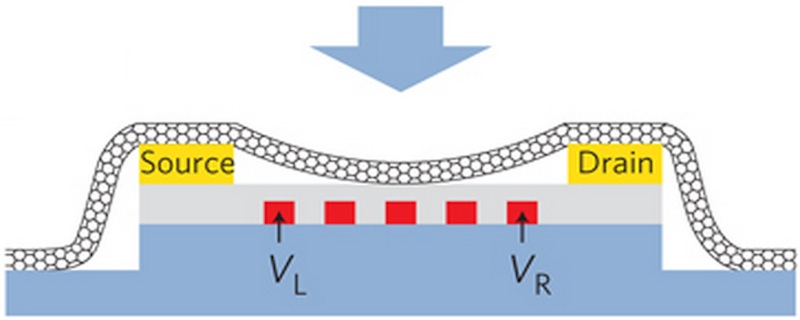This page lists Oxford groups whose quantum research focuses on molecular systems (including synthesis and characterisation of molecular structures, and incorporation of such structures into nanoelectronics) and solid state systems including a range of spin based and optoelectronic quantum devices.
Robert Taylor's Group:
Quantum Optoelectronics
(Physics Department)
Image: Coupled photonic crystal cavity with embedded quantum dots.
Studying the dynamics of photoexcited electrons and holes using measurements on the timescale of about 100 femtoseconds by ultrafast optical spectroscopy. The dynamics are interesting both from a fundamental point of view, and because they limit the speed ultimately obtainable in electronic and opto-electronic devices.
Leader: Robert Taylor
Postdocs:
Ben Reid
David Coles
Students:
Christopher Chan and Hee Dae Kim.
Simon Benjamin's Group:
Quantum and Nanotechnology Theory
(Materials Department)
Image: Artist's impression of fault tolerant 'toric' quantum network.
Working out the theoretical underpinnings for future quantum technologies: sensors, simulators, secure communications systems, and full scale quantum computers. Also studying energy flow in nanoscale natural and artificial systems.
Leader: Simon Benjamin
Postdocs:
Balint Koczor
Students:
Xiaosi Xu, Zhenyu Cai, Tyson Jones, Carlos Outeiral, Sam McArdle, Richard Meister, Sam Jaques, Armands Strikis
Edward Laird and Andrew Briggs' Group:
Nanotube devices
(Materials Department)
Image: Nanotube interfaced to nanoelectronic circuitry.
Creating devices that interface nanoelectronic circuits to single nanotubes, in order to access the vibrational modes of the tube and interface them with (e.g.) spin quantum bits.
Leaders: Prof. Andrew Briggs (Professor of Nanomaterials) and
Dr. Edward Laird (Senior Fellow, RAEng Research Fellow)
Postdocs: Jan Mol, Tian Pei, Natalia Ares, Aquila Mavalankar, Pascal Gehrin
Students: Greg Rogers, Aaron Lau, Alex Barbaro, Matthias Mergenthaler,
Pawel Puczkarski, Felix Schupp
Stephanie Simmons' Group:
Nuclear and Electron Spin Devices
(Materials Department)
Image: Artist's impression of control field to manipulate spin qubit.
Engineering devices to store and manipulate information in the form of 'spin', a property of individual electrons and the nuclei of certain atoms. The spin is a superb choice for storing quantum bits (qubits) because it interacts relatively weakly with other degrees of freedom such as electric charge, and therefore it can persist for long periods - up to hours in the case of nuclear spins.
Leader: Stephanie Simmons
Postdoc: To start Oct 1st 2013
Link to this group's website
Jason Smith's Group:
Photonic Nanomaterials
(Materials Department)
Image: Coupling a nanoparticle light emitter to an open microcavity.
Engineering the light-matter interaction at the single particle level. We work on optical microcavities, semiconductor quantum dots, colour centres in diamond, and nanoplasmonics. We aim to develop nanomaterials and devices with quantum properties leading to new or enhanced functionality.
Leader: Jason Smith
Postdocs:
Aurelien Trichet and Dave Coles
Students:
Sam Johnson, Johnny Fill, Robin Patel, Larry Chen (from October), Lucas Flatten (from October)
Link to this group's own website
Peter Leek's Group:
Quantum Devices
(Physics Department)
Image: Superconducting resonantor structure.
Fabricating circuits from superconductors and operating them at microwave frequencies and very low temperatures. These devices can be used to both study quantum physics itself and exploited for quantum information technology.
Leader: Peter Leek
Students:
Einar Magnusson, Ani Nersisyan and Michael Peterer.
Link to group's own website
Harry Anderson's Group:
Molecular Engineering
(Chemistry Department)
Image: Rotaxane molecular structure.
Designing and synthesising new molecular materials, and explores how their properties relate to their molecular structures. This is "molecular engineering" – engineering at the nanoscale. The group creates structures that are vital to studies of quantum phenomena in Physics and Materials.
Leader: Harry Anderson
Postdocs: Total of five, of whom one or two will typically be synthesising structures for quantum studies.
Students:
Total of six, of whom two will typically be synthesising molecular structures such as, e.g., biomimetic porphyrin rings for studies of quantum coherence of optically excited states (see Herz group).
Laura Herz's Group:
Organic Semiconductors
(Physics Department)
Image: Layer of porphyrin nanorings may mimic photosynthesis.
Light-harversting in natural photosynthetic organisms can be remarkably fast and efficient, because the excited states can be delocalized over several molecular units as one quantum-mechanical state. We explore how such delocalised excited states may be used in synthetic, man-made molecules that may be incorporated in a new generation of efficient photovoltaic materials.
Leader: Laura Herz
Postdoc: Patrick Parkinson
Students: Beate Dirks, Chris Menelaou, Christian Wehrenfennig, Christian Weisspfennig.
Jamie Warner & Kyriakos Porfyrakis Group:
Fullerenes, Nanotubes & Graphene
(Materials Department)
Image: Atomic scale image of graphene with an impurity cluster.
Synthesis of novel molecular materials and devices; imaging beyond the atomic scale (billionths of a centimetre).
Leaders: Jamie H. Warner and Kyriakos Porfyrakis
Associated professors:
Andrew Briggs and Angus Kirkland
Postdocs:
Christopher Allen, Guoquan Liu, Yimin Wu
Students:
Ben Farrington, Alexander Robertson, Kuang He, Ye Fan, Zhengy He, Youmin Rong and Yi Han (Masters).
Clary, Manolopoulos, McGrady & Paton's
Theoretical Chemistry Groups
(note there is another Theo. Chem. team here)
Artist's image 'Atom' (c) ajrchua at deviantART.com.
These groups in theoretical chemistry study a range of topics broadly associated with understanding molecular systems at the quantum level. Focus areas include chemical reaction dynamics, quantum nuclear dynamics in condensed phases, and applied quantum chemical studies of electronic structure, bonding and catalysis.
Leaders: David Clary, David Manolopoulos, John McGrady and Robert Paton.
Postdocs and Students: At any given time there are about a dozen PDRAs and students working in this area; please see the link below for more details.
Alexy Karenowska's Group:
Quantum Magnonics
(Physics Department)
Image: Magnon propagation in a dynamic magnonic metamaterial.
Exploring the interface between the physics of magnonic and magnon spintronic systems and the techniques of microwave circuit based quantum measurement and information processing.
Leader: Alexy Karenowska
Postdoc: One to commence 2014.
Link to group's webpage [pending]










